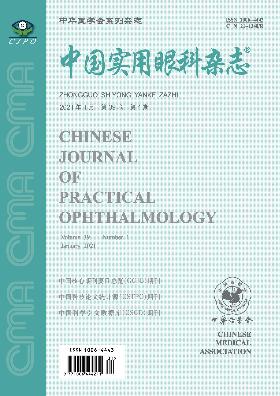雷尼单抗玻璃体内注射治疗早产儿视网膜病变的疗效分析
引用次数: 0
摘要
目的评价雷尼单抗(IVR)治疗早产儿阈值性视网膜病变(ROP)的疗效。方法对诊断为阈值性ROP的早产儿98例(190眼)进行回顾性分析。所有患儿均在诊断后24小时内给予IVR (10 mg/ml, 0.025ml)作为初始治疗。注射后前3天进行前段检查,治疗后第3天、第1周、第3周、第8周进行眼底检查,并根据病情及正确胎龄确定随访检查时间。随访8 ~ 48周,平均(32.1±10.5)周。如果婴儿对治疗反应不积极,则再次进行IVR或激光光凝治疗。结果接受IVR注射后,128眼(67.37%)出现ROP下降。其中,单次注射可观察到视网膜周围血管发育的有105只(55.26%);重复注射23眼临床改善(12.11%);病变稳定56眼(29.47%);需要提前治疗的疾病6眼(3.16%)。结论IVR对大多数阈值ROP患儿是安全有效的。如果复发或无反应,则需要常规激光治疗或额外的IVR注射。关键词:视网膜病变;早产儿阈值性视网膜病变;治疗;Intravitreal之初本文章由计算机程序翻译,如有差异,请以英文原文为准。
Curative effect analysis of intravitreal Ranibizumab for the treatment of retinopathy of prematurity
Objective
To evaluate the efficacy of intravitreal ranibizumab (IVR) for the treatment of threshold retinopathy of prematurity (ROP).
Methods
A total of 98 premature infants (190 eyes) with diagnosis of threshold ROP were reviewed and analyzed in this study. All the infants received IVR (10 mg/ml, 0.025ml) as the initial treatment within 24 hours after diagnosis. Anterior segment examinations were performed after injection in first 3 days, and fundus examination were performed after treatment in third day, first week third week and eighth week, and determined the follow-up examinations time according to condition and correct gestational age. Follow-up ranged from 8 to 48 weeks, and the average follow-up time was (32.1±10.5) weeks. If the infants didn’t respond positively to the treatment, IVR or laser photocoagulation treatment was performed once more.
Results
After receiving IVR injections, 128 eyes (67.37%) exhibited ROP regression. Among the eyes, the development of peripheral retinal vessels could be observed in 105 eyes (55.26%) which received a single injection; clinical improvement in 23 eye (12.11%) which received repeat injection; stable disease in 56 eyes (29.47%) which received laser therapy; needing-advance treatment disease in 6 eyes (3.16%).
Conclusions
IVR is safe and effective for most threshold ROP infants. In cases of recurrence or no response, conventional laser treatment or an additional IVR injection were needed for the others.
Key words:
Retinopathy; Threshold retinopathy of prematurity; Treatment; Intravitreal ranibizumab
求助全文
通过发布文献求助,成功后即可免费获取论文全文。
去求助
来源期刊
自引率
0.00%
发文量
9101
期刊介绍:
China Practical Ophthalmology was founded in May 1983. It is supervised by the National Health Commission of the People's Republic of China, sponsored by the Chinese Medical Association and China Medical University, and publicly distributed at home and abroad. It is a national-level excellent core academic journal of comprehensive ophthalmology and a series of journals of the Chinese Medical Association.
China Practical Ophthalmology aims to guide and improve the theoretical level and actual clinical diagnosis and treatment ability of frontline ophthalmologists in my country. It is characterized by close integration with clinical practice, and timely publishes academic articles and scientific research results with high practical value to clinicians, so that readers can understand and use them, improve the theoretical level and diagnosis and treatment ability of ophthalmologists, help and support their innovative development, and is deeply welcomed and loved by ophthalmologists and readers.

 求助内容:
求助内容: 应助结果提醒方式:
应助结果提醒方式:


